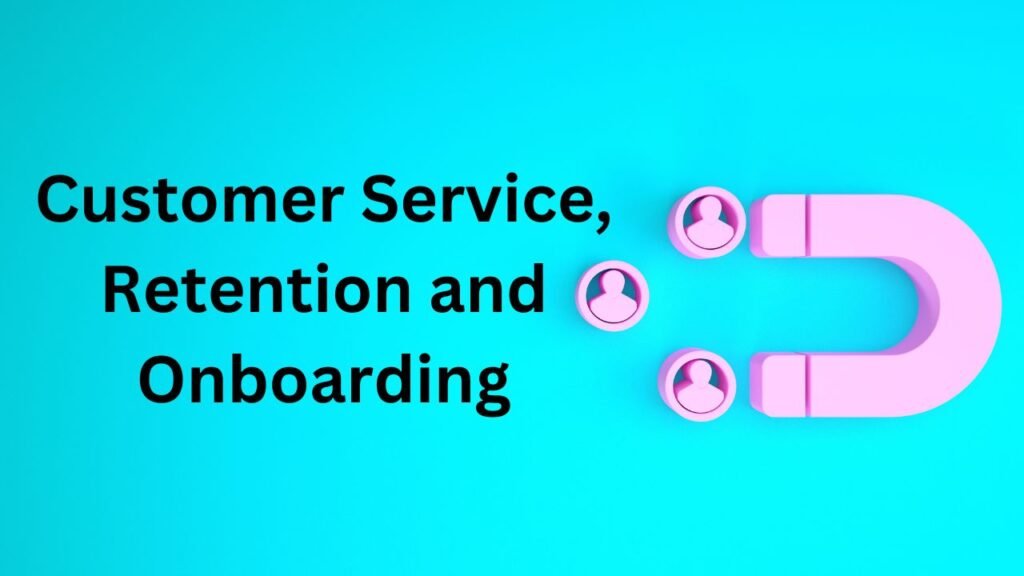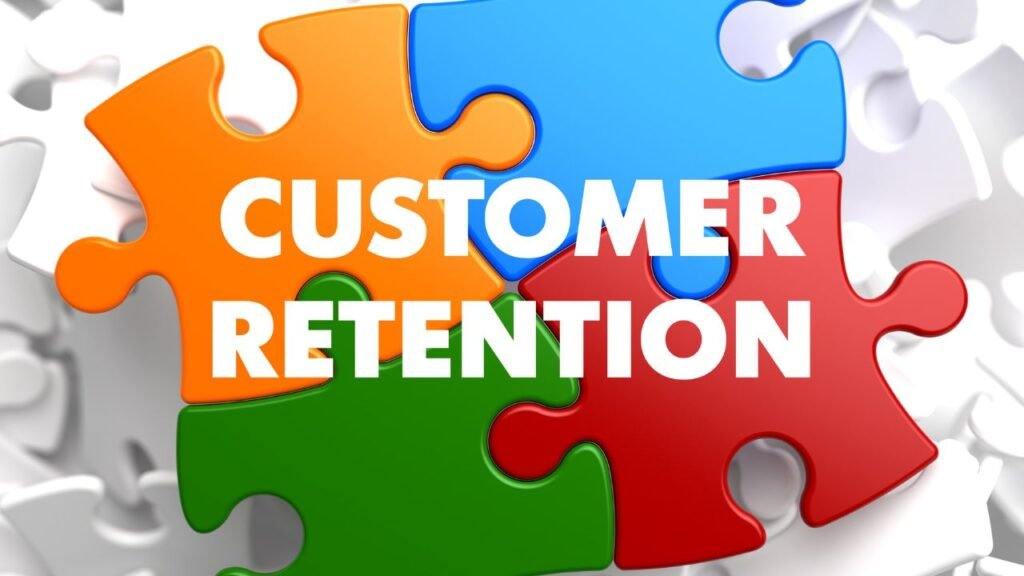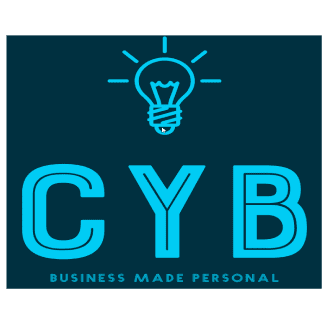Did you know that almost 74% of potential customers will decide to move on with your competitors if you provide a complex onboarding process for them? This means that the other fish in the sea got to the meal first, leaving your company grappling with the aftermath of losing customers.
But that’s not all – customer service and onboarding are crucial factors that can make or break your company. A staggering 68% of consumers are willing to pay extra for products and services from a brand known for delivering exceptional customer service experiences. These stats are only the tip of the iceberg that’s proof for you to see the importance of customer service and retention.
Let’s find out some expert strategies to improve your customer service, loyalty, and retention.
What is Customer Service, Retention, and Onboarding?

- Customer Service
Customer service is like having a helpful friend at a store. It’s the support and assistance you get from a company when you have questions, problems, or just need guidance. Good customer service makes you feel heard and valued, creating a positive connection between you and the company.
- Retention
Think of customer retention as a company’s way of saying, “We want you to stick around!” It’s all about keeping existing customers happy and coming back for more. Businesses do this by making sure you enjoy your experience, offering special deals, and creating a vibe that makes you want to stay part of their community.
- Onboarding
Onboarding is like a friendly guide showing you around a new place. When you start using a new product or service, onboarding is the process that helps you get the hang of things. It’s the company’s way of making sure you feel comfortable, understand how things work, and get the most out of what they offer.
Customer Onboarding Best Practices
Just think about this scenario for a moment—you go and buy yourself a good iPhone from the Apple store. Once you pay for it, the salesperson hushes you out of the door with the product in your hand without explaining a little bit about the features, the guarantee or anything. Would you be going back to that store again? If no is your answer, then this is something you can prevent from happening with YOUR customers.
Customer onboarding is the beginning of everything, and this makes it extra important. The way you plan out this beginning for your customers is what will affect their experience with your business till the end. Here are some strategies to help you smooth out your customer onboarding process:
Plan out a Clear Roadmap
Help your clients navigate smoothly by providing a clear roadmap. Imagine the frustration of feeling lost during onboarding – that’s something we want to avoid. Create a well-thought-out journey for your clients so they always know what’s coming next. It’s about crafting a planned and reassuring experience.
Consider this simple client onboarding roadmap:
- Select the Product: Choose what suits you best.
- Product Orientation: Understand how it works.
- Discuss Warranty: Know your coverage.
- Sign Contract: Make it official.
- Turn Over Product: It’s all yours now.
- Get Feedback: Share your thoughts.
There are endless possibilities for roadmaps, but the key is to provide clarity.
Different customers, Different Onboarding
Not every user is the same, and their interaction with your product varies. A one-size-fits-all onboarding approach might not cut it, making it challenging to build genuine connections.
That’s where contextual onboarding comes in. It tailors prompts, checklists, and instructions based on different user types. Instead of a generic approach, it adapts to individual needs.
Contextual onboarding introduces new features as users engage with the platform. By using analytics and custom events, it triggers prompts precisely when users need guidance. It’s all about understanding each user’s journey and providing the right help at the right time.
Set Realistic Expectations
Before your clients start using your product or service, it’s a good idea to talk about what they expect and set some milestones. This way, you both understand what the other wants, creating a clear picture of what your offering can do. This tip is especially handy for agencies because it helps avoid misunderstandings about what’s expected in terms of results and deliverables. It’s like making sure everyone’s on the same page from the beginning so the journey together is smooth and successful.
Promise a Win
Guide users toward an early victory during the onboarding process to build momentum. While you might not solve all their challenges right away, you can demonstrate progress. Providing users with a quick win in the initial onboarding interactions is key – it’s like showing them a glimpse of the positive outcomes ahead.
The type of win you aim for should align with the user’s ultimate goal. For instance, consider Canva – a small business owner’s goal might be to reduce graphic design costs. Although they might not see immediate financial results, Canva can showcase how effortlessly they can create high-quality visuals.
Take Help from AI
Make your onboarding process smooth and efficient by establishing a repeatable customer onboarding framework. Winging it every time can waste both your and the client’s time, so automate where you can. One effective way is to pre-record straightforward segments, especially since 97% of people find videos great for onboarding.
Another useful automation is using an email sequence. This set of automated emails can provide instructions, follow-ups, surveys, and upsells over a set period. It keeps things organized and paced. Of course, always leave room for special requests or questions.
Back the Onboarding with Data
Improve your onboarding process by automating with an email sequence. This set of automated emails guides users with instructions, follow-ups, surveys, and upsells over time, maintaining an organized and paced approach. Always keep space for special requests or questions.
For smarter decision-making, use data to refine your onboarding experience. Backing your choices with data reduces risks and ensures alignment with customer expectations. Besides product analytics, gather insights from one-on-one user conversations, social media, reviews, competitor analysis, and industry trends.
Expert Customer Retention Strategies

Did you know it costs 5 to 25 times more for a business to gain a new customer than to retain one. This is why you will notice that most companies place a very strong emphasis on their customer retention because old clients always have room for improvement.
Here are some ways you can also retain old customers with just a few strategies:
Personalize your Customer’s Journey
Make each user’s journey unique by personalizing experiences at every stage. The good news is if you’ve taken the time to understand your users, this becomes not only easy but enjoyable.
Consider what your customer needs for a smooth journey from Point A to Point Buy. A user-friendly design boosts the overall experience (UX), and a consistently pleasant, personalized product experience (PX) helps keep users engaged and reduces churn. Every interaction users have with your brand and product plays a role in shaping your customer retention rate.
Quick Response to Customer Queries
Getting back to customer support queries quickly is a big deal. Our 2021 CX Trends Report found that 73% of customers believe speedy support resolutions make a real difference in their experience.
Even if you can’t solve the issue right away, just acknowledging their question ASAP matters. A quick message saying you got their query or, better yet, giving them an idea of when you’ll fix things makes a positive impact.
Customers are more patient when they know you’re actively working on a solution. So, keeping them in the loop and setting expectations about when things will be sorted out goes a long way.
Give Back for Loyalty
Keep your customers coming back by showing them some love for their loyalty. It’s not just about having a great product; it’s about making them feel appreciated.
Here are some ways to do that:
- Loyalty Programs: Get rewarded for sticking around.
- Discount Codes: Special discounts just for being awesome.
- Special Offers: Exclusive deals because you’re special.
- VIP Events: Access to cool events reserved for the VIPs.
- Early-Access Benefits: Be the first to try out new stuff.
Loyalty programs come in different flavors, like earning points or getting tiered rewards. Plus, they help us get to know you better so we can make your experience even more personal. It’s a little way of saying thanks for being part of our journey!
Listen to Feedback
Listening to your customers is gold when it comes to boosting customer retention and lowering churn rates. If you want to understand what’s working and what needs improvement, go straight to the source.
Empower your customers by conducting surveys. Sure, you can keep it simple with a quick “thumbs up or thumbs down” after solving an issue. But it’s even more insightful to ask some specific questions like:
- How was your experience with our product?
- What’s not working for you and why?
- Which customer support channel do you prefer?
And don’t forget to tap into the wisdom of your customer service team. They’re on the frontline, hearing customer concerns and preferences every day. It’s like getting the inside scoop to make sure you’re always on the right track.
Customer Service Essentials Every Business Should Know
Customers are your EVERYTHING. They are the ones who ultimately decide the fate of your service, product, or brand, and there are ways to give back to them. Customer support goes beyond transactional exchanges. It’s about creating a connection, understanding needs, and exceeding all expectations of your loyal customers who have helped build your brand from scratch.
Here are some basic strategies that’ll help you improve your customer service:
Active Listening
Think of it as a heart-to-heart conversation with a close friend. Active listening in customer service isn’t merely problem-solving; it’s about giving customers the space to express themselves without interruption. It’s a practice that goes beyond the surface, aiming to make customers feel genuinely valued and understood.
Timely Responses
When you keep up timely responses with your customers, it shows them that you care about the urgency of their matter. These responses can be in any form, whether its email, social media, or even a simple call. Giving a timely response gives your customers an idea that you’re actually committed to finding the solution to their problem.
Empathy and Understanding
Think of a time when you were trying to understand something really hard, and then BINGO! You finally got it. If you also want to understand what and how your customer is thinking, then you have to get in their shoes. Being an empath actually starts from considering your customer’s emotions. Is the product not helping them in some way? Is there any problem they are facing with your service? Why are they not satisfied? This shows that your company is aware of the situation and is there to provide all the support you need.
Continuous Improvement
Customer service is not a one-time thing that you can sign off and forget about. It actually needs continuous improvement from your side to make it work in the long term. Try to regularly get feedback from your customers. Don’t be afraid if it’s good or bad; any kind of feedback can help your service improve one way or another. And you know what else it does? It signals your clients that you hear their input and are working on fixing it.
10 Important Statistics related to Customer Service, Retention and Onboarding

Technology Impact on B2B Expectations
Insight: Nearly 8 out of 10 B2B clients feel that technology has significantly changed how they expect companies to interact with them. (Source)
Crucial Personalized Experience
Insight: More than 50% of customers believe that a personalized experience can be a dealbreaker for them. Now you know the power of customizing your onboarding. (Source)
Understanding Product Usage Importance
Insight: 70% of customers feel companies should get an idea of how the customers understand and use their products if they want a good future. (Source)
Repeat Purchases Linked to Excellent Customer Service
Insight: A whopping 93% of customers are likely to show up at the same Apple store or buy any other product if their customer service game is on point! Do you see the connection between service quality and customer loyalty? That’s exactly what you need to nail! (Source)
Profit Increase Through Customer Retention
Insight: This one is going to surprise you. According to Harvard Business Review, tweaking your customer retention by a small margin can lead to a massive profit boost of 25% to 95%! (Source)
Abandonment Rate Due to Lengthy Onboarding
Insight: If the onboarding process is more than 20 minutes, more than 70% of your potential customers will abandon everything and leave for your competitor. (Source)
Use of Customer Satisfaction Scores for Analysis
Insight: 80% of companies utilize customer satisfaction scores to improve their experience for customers. This shows how valuable of a tool customer feedback is. (Source)
Enterprise Organizations and Onboarding Strategy
Insight: 82% of enterprise organizations think of their onboarding strategy as a key driver of value. (Source)
Loyalty Linked to Onboarding and Continuous Education
Insight: And the last cherry on top, a whopping 86% of customers say that they will stay loyal to your business if you provide good onboarding and continuous education for them.(Source)
How does Customer Retention Affect a Business?
Holding onto customers is like having your ride-or-die buddies in business. It’s not just about the cash; it shows that people genuinely dig what you’re putting out there. When customers stick around, they like to spread the word about how amazing your business is – and that kind of talk is like hitting the jackpot.
Think of it this way: keeping the customers you already know happy is way smarter than always trying to find new ones. Businesses that focus on keeping their customers grinning spend less time and money on the endless hunt for new ones, as we saw in the research.
But it’s not just about the dollars; it’s about building a whole community. It’s about really getting each customer, knowing their likes, and making sure they’re always having a good time. Businesses that genuinely care about their customers aren’t just about pushing products; they’re about creating a connection that makes people stick around.
Wrapping Up
But at the end of the day, it’s not just about business – it’s about making connections, building a following, and making every moment count. So whether you’re the one giving the service or the one enjoying it, remember, it’s the human touch that turns a simple deal into a long-lasting friendship. And that’s where the real success story kicks in. Cheers to that!


